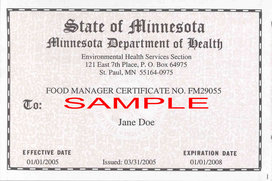Although we always hope that disaster never strikes, occasions may happen over the course of a food manager’s career when they have to deal with a fire, a burst water pipe or another event that damages their facility. Occasionally, the topic comes up in a ServSafe class, and a student inevitably asks if there is any way to save product in these situations.

Discard or Salvage: A ServSafe Class Guide
There are a few different situations that can cause harm to food products. A fire can cause heat or smoke damage, water line leaks can create rust and sewage back-ups can infect food product, but does that mean that whenever there an incident occurs you must discard your entire inventory?
The following list clarifies unsalvageable items:
- Fresh produce, proteins and dairy that comes in contact with water, smoke or sewage
- Food in soft packaging such as cardboard
- Dry goods such as flour and spices
- Charred, rusted, swollen or leaking canned goods
- Single service items such as plates and utensils
If the incident has occurred in your refrigerator, discard all items that have stayed at temperatures above 41 degrees for four hours. If any item has an unusual smell, texture or color, play it safe and throw it out. You also cannot salvage any previously frozen item that has thawed for two or more hours.
If you have any doubts whatsoever, don’t take any chances and discard items that may have come into contact with smoke or sewage.
The damage from a fire or sewage backup may not necessarily cause a total loss. A few items are salvageable under certain conditions. You can save sealed frozen foods that haven’t fallen below 41 degrees. Undamaged cans and bottles that have not suffered any damage due to heat require sanitation after the incident. In this instance, remove all paper labels and relabel the goods in permanent marker. If you have product in an area unaffected by the incident, inspect it for damage before deciding whether to save it or throw it away.
If a fire or sewage leak occurs in your facility, seek the advice of the local health department. They will easily clarify salvage rules, and they will provide on-site assistance to help you keep your existing product safe.
Fire, water and sewage catastrophes happen more often that we would like. Are there any unique disaster scenarios you’d like to see us cover in an upcoming article?





